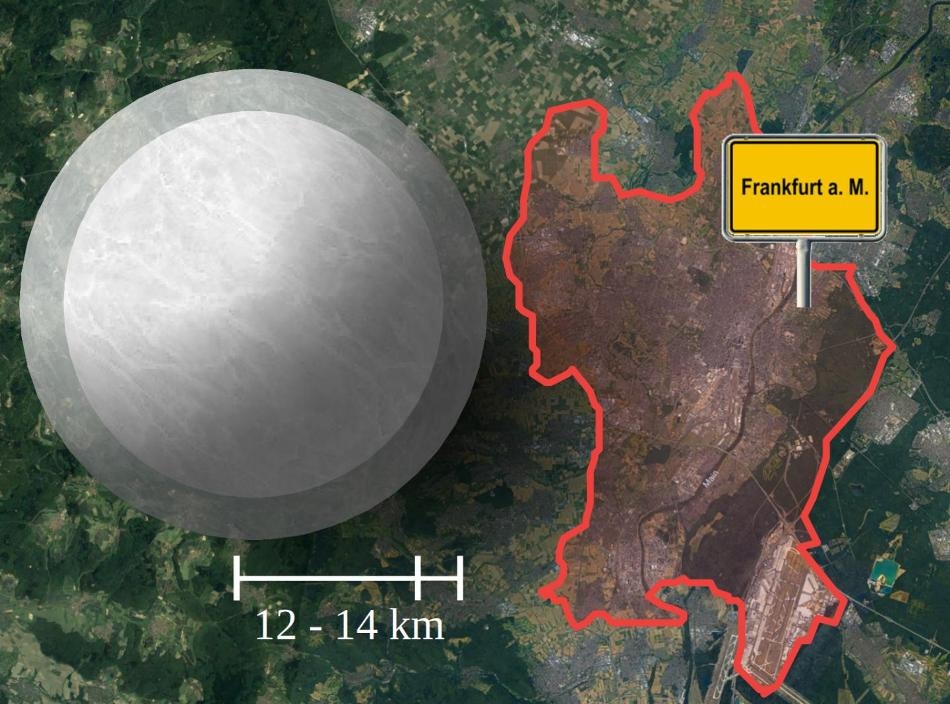Jun 27 2018
What is the size of a neutron star? Earlier evaluations showed that it varied from 8 to 16 km. At present, astrophysicists from the Goethe University Frankfurt and the FIAS have been successful in determining the size of neutron stars to be less than 1.5 km.
 The size range for a typical neutron star compared to the city of Frankfurt.(Image credit: Lukas Weih, Goethe University; satellite image: GeoBasis-DE/BKG (2009) Google)
The size range for a typical neutron star compared to the city of Frankfurt.(Image credit: Lukas Weih, Goethe University; satellite image: GeoBasis-DE/BKG (2009) Google)
To achieve this they used an elaborate statistical approach, which was supported by data obtained from the measurement of gravitational waves. The outcomes of the study have been published in the latest issue of Physical Review Letters.
Neutron stars are the densest objects in the universe and have a mass that is larger than that of our sun compressed into a comparatively small sphere with a diameter that is comparable to that of the city of Frankfurt.
However, this is in fact a rough approximation. For over four decades, determining the size of neutron stars has been impossible in the field of nuclear physics, the solution of which would offer vital information related to the fundamental behavior of matter at nuclear densities.
The data obtained as a result of detecting gravitational waves from merging neutron stars (GW170817) are significant in finding a solution to this puzzle.
At the end of 2017, Professor Luciano Rezzolla, from the Institute for Theoretical Physics at the Goethe University Frankfurt and FIAS, worked along with his students Elias Most and Lukas Weih to already exploit this data to provide a long-sought answer to the question related to the maximum mass that can be supported by neutron stars before collapsing to a black hole.
After this first significant outcome, the same group, with assistance from Professor Juergen Schaffner-Bielich, has strived to set more stringent constraints on the size of neutron stars.
The essence of the topic is that the equation of state describing the matter contained in neutron stars is unidentified. Hence, the physicists resolved to follow another path: they chose statistical techniques to ascertain the size of neutron stars within constrained limits.
The new limits were set by computing over two billion theoretical models of neutron stars by solving the Einstein equations that describe the equilibrium of these relativistic stars and integrated this large dataset with the restrictions arising from the GW170817 gravitational wave detection.
An approach of this type is not unusual in theoretical physics. By exploring the results for all possible values of the parameters, we can effectively reduce our uncertainties.”
Professor Luciano Rezzolla
Consequently, the researchers could determine the radius of a typical neutron star within a range of just 1.5 km: it is between 12 and 13.5 km, a result that could be refined even more by gravitational wave detections in the future.
“However, there is a twist to all this, as neutron stars can have twin solutions,” commented Schaffner-Bielich. In fact, it is possible that at ultra-high densities, there are dramatic changes in the properties of matter and it undergoes a so-called “phase transition".
This is analogous to the impact on water when it freezes and transforms from a liquid to a solid state. When it comes to neutron stars, it is hypothesized that this transformation turns ordinary matter into “quark matter,” giving rise to stars with precisely the same mass as their neutron star “twin,” but which is considerably smaller and, as a result, highly compact.
Although there is no explicit proof for their existence, they are credible solutions and the Frankfurt scientists have taken this credibility into account, in spite of the additional complications implied by twin stars.
This effort eventually turned out to be fruitful as their calculations have led to an unanticipated outcome: twin stars are statistically uncommon and it is not possible to deform them much when two such stars merge.
This is discovery will enable researchers to prospectively obviate the existence of these highly compact objects. Future gravitational-wave observations will unveil whether or not exotic twins exist for neutron stars.